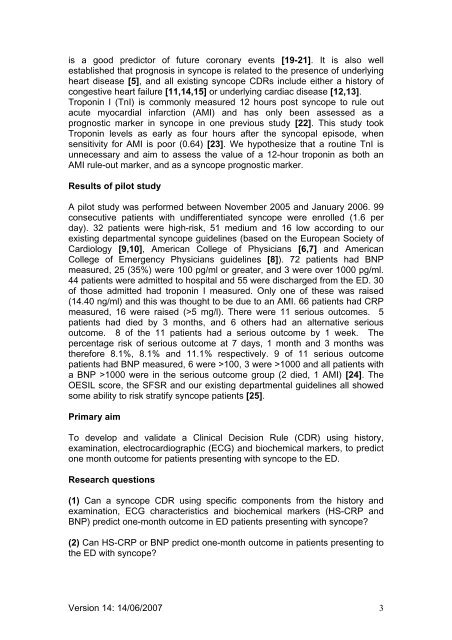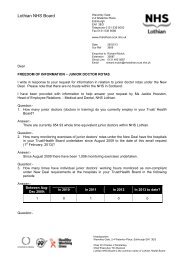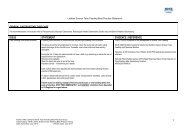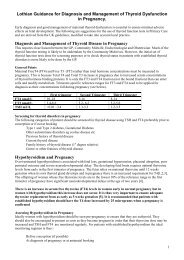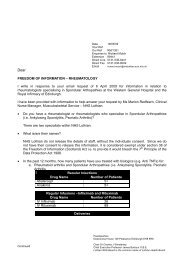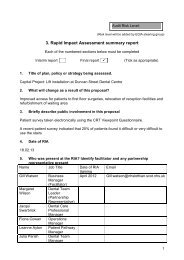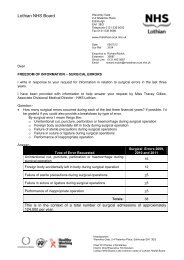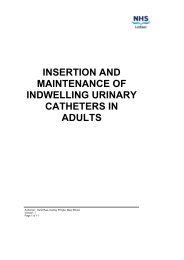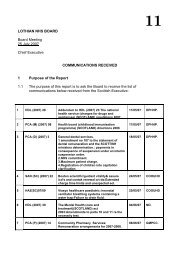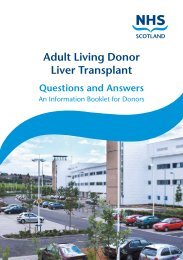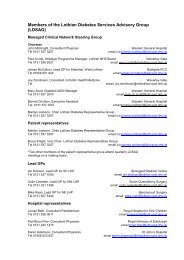Submission for Lancet Protocol Review Title A study ... - NHS Lothian
Submission for Lancet Protocol Review Title A study ... - NHS Lothian
Submission for Lancet Protocol Review Title A study ... - NHS Lothian
You also want an ePaper? Increase the reach of your titles
YUMPU automatically turns print PDFs into web optimized ePapers that Google loves.
is a good predictor of future coronary events [19-21]. It is also well<br />
established that prognosis in syncope is related to the presence of underlying<br />
heart disease [5], and all existing syncope CDRs include either a history of<br />
congestive heart failure [11,14,15] or underlying cardiac disease [12,13].<br />
Troponin I (TnI) is commonly measured 12 hours post syncope to rule out<br />
acute myocardial infarction (AMI) and has only been assessed as a<br />
prognostic marker in syncope in one previous <strong>study</strong> [22]. This <strong>study</strong> took<br />
Troponin levels as early as four hours after the syncopal episode, when<br />
sensitivity <strong>for</strong> AMI is poor (0.64) [23]. We hypothesize that a routine TnI is<br />
unnecessary and aim to assess the value of a 12-hour troponin as both an<br />
AMI rule-out marker, and as a syncope prognostic marker.<br />
Results of pilot <strong>study</strong><br />
A pilot <strong>study</strong> was per<strong>for</strong>med between November 2005 and January 2006. 99<br />
consecutive patients with undifferentiated syncope were enrolled (1.6 per<br />
day). 32 patients were high-risk, 51 medium and 16 low according to our<br />
existing departmental syncope guidelines (based on the European Society of<br />
Cardiology [9,10], American College of Physicians [6,7] and American<br />
College of Emergency Physicians guidelines [8]). 72 patients had BNP<br />
measured, 25 (35%) were 100 pg/ml or greater, and 3 were over 1000 pg/ml.<br />
44 patients were admitted to hospital and 55 were discharged from the ED. 30<br />
of those admitted had troponin I measured. Only one of these was raised<br />
(14.40 ng/ml) and this was thought to be due to an AMI. 66 patients had CRP<br />
measured, 16 were raised (>5 mg/l). There were 11 serious outcomes. 5<br />
patients had died by 3 months, and 6 others had an alternative serious<br />
outcome. 8 of the 11 patients had a serious outcome by 1 week. The<br />
percentage risk of serious outcome at 7 days, 1 month and 3 months was<br />
there<strong>for</strong>e 8.1%, 8.1% and 11.1% respectively. 9 of 11 serious outcome<br />
patients had BNP measured, 6 were >100, 3 were >1000 and all patients with<br />
a BNP >1000 were in the serious outcome group (2 died, 1 AMI) [24]. The<br />
OESIL score, the SFSR and our existing departmental guidelines all showed<br />
some ability to risk stratify syncope patients [25].<br />
Primary aim<br />
To develop and validate a Clinical Decision Rule (CDR) using history,<br />
examination, electrocardiographic (ECG) and biochemical markers, to predict<br />
one month outcome <strong>for</strong> patients presenting with syncope to the ED.<br />
Research questions<br />
(1) Can a syncope CDR using specific components from the history and<br />
examination, ECG characteristics and biochemical markers (HS-CRP and<br />
BNP) predict one-month outcome in ED patients presenting with syncope?<br />
(2) Can HS-CRP or BNP predict one-month outcome in patients presenting to<br />
the ED with syncope?<br />
Version 14: 14/06/2007 3


